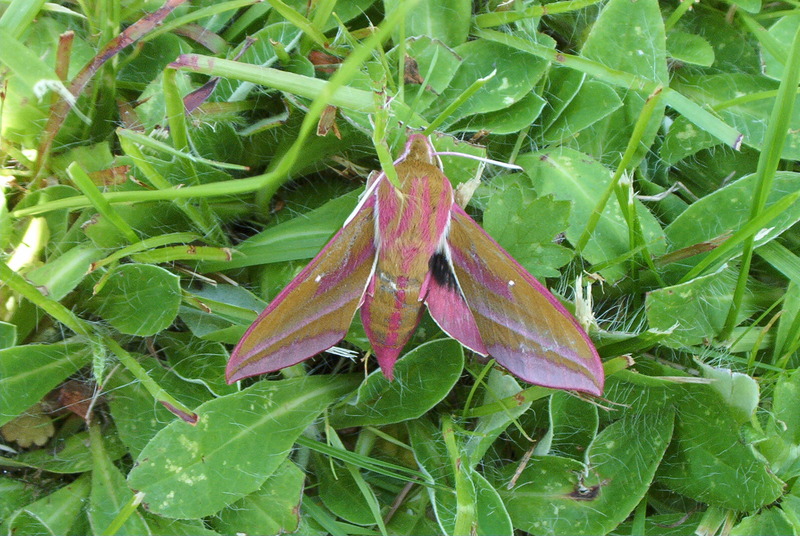|
Elephant Hawk-moth (Deilephila elpenor) - Wiki
| 제목: | Elephant Hawk-moth (Deilephila elpenor) - Wiki
| |

| 해상도: 1792x1200
파일크기: 964354 Bytes
촬영일: 2004:06:07 12:39:00
사진기: hp photosmart 612 (Hewlett-Packard)
F number: f/4.7
Exposure: 11610/1000000 sec
Focal Length: 1086/100
등록시간: 2007:09:11 09:57:06
|
Deilephila elpenor
From Wikipedia, the free encyclopedia
[Photo] Elephant hawk moth. Author: Reinhold Tripp (http://commons.wikimedia.org/wiki/User:Massel_tow). Date: created 07. Jun. 2004
The Elephant Hawk-moth (Deilephila elpenor) is a large moth of the Sphingidae family.
Range
The species is found throughout Britain and Ireland except for the north and east of Scotland, and its range extends across Europe, Russia, and into China, northern parts of the Indian subcontinent, Japan and Korea (though not Taiwan). Introduced specimens have been found in British Columbia. In most of their range, the adults are seen from May to July and the caterpillars from July to September, when they pupate. However in some parts of the Mediterranean and China the adults may be seen from April on, sometimes having two broods in a year.
Appearance
Larva
The larva is about 75mm long, green and brown in colour. Like most hawk moth caterpillars, they have a backward curving spine or "horn" on the final abdominal segment. The anterior of the caterpillar appears to have the shape of a trunk-like snout. It is this elephant look, rather than its large size, that gives the moth its name. When startled, the caterpillar draws its trunk into its foremost body segment. This posture resembles a snake with a large head and four large eye-like patches. Caterpillars are preyed upon by birds, but these shy away (at least for some time) from caterpillars in "snake" pose. It is not known whether the birds take the caterpillar to actually resemble a snake, or are frightened by the sudden change of a familiar prey item into an unusual and boldly-patterned shape (Stevens 2005).
The preferred food plants of the caterpillar are willowherb and bedstraw, though it will also take fuchsias.
Adult
The imago (adult) tends to feed in the evening, and often takes nectar from garden plants like honeysuckles and petunias, so it is quite often seen in urban settings. The moth has a wing span typically between 50 and 70 mm. It is spectacularly coloured, seeming to shimmer with green and red when in motion. The adult moths are eaten by some species of bats.
Subspecies
Two subspecies, Deilephila elpenor elpenor and Deilephila elpenor lewisii, were recognised in the past, but they are no longer regarded as well distinguished. Similarly the subspecies Deilephila elpenor szechuana is now thought to be a synonym for Deilephila elpenor elpenor. The subspecies Deilephila elpenor macromera, found in southern China, northern India, Bhutan and Myanmar, is still regarded as distinct.
The related species, the Small Elephant Hawk-moth (Deilephila porcellus) and Chitral Elephant Hawk-moth (Deilephila rivularis) are similar but smaller and less colourful.
http://en.wikipedia.org/wiki/Deilephila_elpenor
| The text in this page is based on the copyrighted Wikipedia article shown in above URL. It is used under the GNU Free Documentation License. You may redistribute it, verbatim or modified, providing that you comply with the terms of the GFDL. |
|
^o^
동물그림창고 똑똑전화 누리집
^o^
|
|

